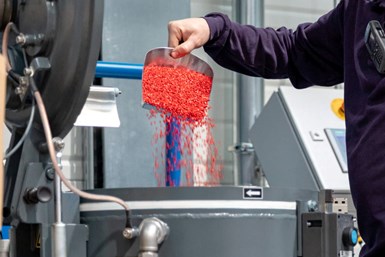Kimya Releases Life Cycle Analysis Results for 3D filaments
Analysis results indicate that using Kimya’s recycled PETG filaments helps reduce CO2 emissions by 35% compared with standard PETG, which the company hopes will encourage users to give priority to recycled filaments in the interests of sustainability and resource conservation.
Kimya, Armor Group’s additive brand, continues expanding its range of recycled 3D filaments to turn waste into a genuine resource. Photo Credit: Kimya
In order to provide users with even more transparency, Kimya, an Armor Group company, recently published the Life Cycle Analysis (LCA) results for its 3D PETG filaments. The analysis concluded that using Kimya’s recycled PETG filaments helps to reduce CO2 emissions by 35% compared with standard PETG.
As a provider of eco-designed 3D materials, Kimya says it hopes to encourage users to give priority to recycled filaments in the interests of sustainability and resource conservation.The LCA is a multistage, multicriteria analysis that measures the environmental impacts generated by a product or service throughout its life cycle — from the extraction of raw materials to the end of life, including manufacturing and use.
Conducted in collaboration with Greenly and based on ADEME guidelines, the LCA of Kimya’s recycled PETG 3D filament shows an emission of 4.08 kg CO2 versus 6.27 kg CO2 for Kimya standard PETG filament. Using recycled filament helps to reduce emissions by 35% when compared with the standard version.
“Born out of our company’s DNA and a strong demand from our distributors, the Life Cycle Analysis, carried out on our standard and recycled PETG filaments, makes it possible to provide users with transparent information on the environmental impact of the materials they use, in order to encourage them to choose more environmentally friendly alternatives,” says Benoît Stoeux, Kimya managing director.
The company says its LCA approach is part of its ongoing commitment to more sustainable production. This include its “Remake” line of recycled filaments that it is continuing to expand. “At the same time, we are also thinking about our packaging, which is now 100% environmentally friendly, using recycled cardboard and soluble ink,” Stoeux says. “Not to mention the mounting flanges for our 3D filament spools, which are now made of 95% recycled polycarbonate. The next step for KIMYA is to conduct a full carbon assessment of our business in orderto accurately quantify ourcarbon footprint and undertake specific measuresto reduce our CO2 emissions.”
Kimya says the impetus is to produce fairly, without wasting resources thanks to 3D printing. According to Sculpteo’s “The State of 3D Printing” 2022 edition, additive manufacturing (AM) improves the environmental impact of activities of the users who were interviewed (managers, engineers, designers); 41% say AM helps companies meet their sustainability goals, and 61% of manufacturers believe the technology enables them to produce in the right quantities for their needs.
“Born out of the determination of the Armor Group to turn waste into a genuine resource, Kimya entered the additive manufacturing market in 2016 by offering its first filament designed using industrial waste from food packaging,” Stoeux adds. “At Kimya, we are convinced that 3D printing is a technology that can produce as close as possible to customer needs, without wasting resources.”
- Listen to this episode of AM Radio to hear how Kimya and Armor Group look to 3D printing to help close the loop for Armor’s circular economy with manufacturing 3D printing filament to recycle its own reclaimed plastic waste.
- Learn how Kimya is working to expand its range of recycled high-performance 3D Filaments, with researchers targeting between 70% and 100% recycled materials in so-called high-performance filaments, without affecting the properties.
- On this episode of AM Radio, listen to AM editors discuss Stratasys materials collaborations with Kimya and more.
Related Content
Copper, New Metal Printing Processes, Upgrades Based on Software and More from Formnext 2023: AM Radio #46
Formnext 2023 showed that additive manufacturing may be maturing, but it is certainly not stagnant. In this episode, we dive into observations around technology enhancements, new processes and materials, robots, sustainability and more trends from the show.
Read MoreConcept Sneaker Boasts One-Piece 3D Printed TPU Construction
The Reebok x Botter Concept Sneaker Engineered by HP premiered at Paris Fashion Week, hinting at manufacturing possibilities for the future of footwear.
Read MoreHow 3D Printing Aids Sustainability for Semiconductor Equipment: The Cool Parts Show Bonus
Hittech worked with its customer to replace fully machined semiconductor trays with trays made via DED by Norsk Titanium. The result is dramatic savings in tool consumption and material waste.
Read MoreMachine Tool Drawbar Made With Additive Manufacturing Saves DMG MORI 90% Lead Time and 67% CO2 Emission
A new production process for the multimetal drawbar replaces an outsourced plating step with directed energy deposition, performing this DED along with roughing, finishing and grinding on a single machine.
Read MoreRead Next
Profilometry-Based Indentation Plastometry (PIP) as an Alternative to Standard Tensile Testing
UK-based Plastometrex offers a benchtop testing device utilizing PIP to quickly and easily analyze the yield strength, tensile strength and uniform elongation of samples and even printed parts. The solution is particularly useful for additive manufacturing.
Read More3D Printed Polymer EOAT Increases Safety of Cobots
Contract manufacturer Anubis 3D applies polymer 3D printing processes to manufacture cobot tooling that is lightweight, smooth and safer for human interaction.
Read MoreCrushable Lattices: The Lightweight Structures That Will Protect an Interplanetary Payload
NASA uses laser powder bed fusion plus chemical etching to create the lattice forms engineered to keep Mars rocks safe during a crash landing on Earth.
Read More





















